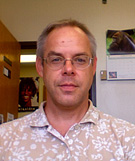Osbjorn Pearson
Professor and Regents' Lecturer

Archaeology, Evolutionary Anthropology
- At UNM since
- 1999
- Email:
- ompear@unm.edu
- Curriculum vitae
Recent Courses:
- Introduction to Anthropology (ANTH 101)
- Evolution and Human Emergence (ANTH 150)
- Human Evolution Laboratory (ANTH 151L)
- Human Biology (ANTH 350)
- Anthropology of the Human Skeleton (ANTH 351)
- Human Origins (ANTH 357)
- Paleoanthropology (ANTH 457/557)
- Reconstructing Life from the Skeleton (ANTH 458)
- Inferring Behavior from the Skeleton (ANTH 556)
- Seminar (co-taught with Dr. L. Straus) - The Middle to Upper Paleolithic Transition (ANTH 577)
- Seminar (co-taught with Dr. L. Straus) - European Prehistory: The Middle to Upper Paleolithic Transition (ANTH 577)
Education:
BA, University of Texas at Austin, Anthropology (1990)
MA, State University of New York at Stony Brook, Anthropological Sciences (1995)
PhD, State University of New York at Stony Brook (1997)
Dissertation: “Postcranial Morphology and the Origin of Modern Humans”
Research:
Paleoanthropology, origin of modern humans, skeletal biology, functional morphology, quantitative methods; Africa, Europe
Recent Publications:
Pearson, O. M., Hill, E. C., Peppe, D. J., Van Plantinga, A., Blegen, N., Faith, J. T., Tryon, C. A. A human humerus from a late Middle Stone Age context on Rusinga Island, Lake Victoria, Kenya. Journal of Human Evolution; vol. 146; p. 102855; 2020.
Pearson, O. M., Pablos, A., Rak, Y., and Hovers, E. A partial Neandertal foot from the late Mousterian of Amud Cave, Israel. PaleoAnthropology; vol. 2020; pp. 98-125; 2020.
Hill, E. C., Durband, A. C., Pearson, O. M., Walshe, K. Does upper limb robusticity and bilateral asymmetry support subsistence intensification at Roonka, South Australia? Australian Archaeology; 2020.
Hill, E. C., Pearson, O. M., Durand, A. C., Walshe, K., Carlson, K. J., and Grine, F. E. An examination of cross-sectional geometrical properties of Holocene foragers from Roonka, South Australia. American Journal of Physical Anthropology, 2020, pp. 1-16. 2020.
Assefa, Z., A. Asrat, E. Hovers, Y. Lam, O. Pearson, and D. Pleurdeau. Engraved ostrich eggshell from the Middle Stone Age contexts of Goda Buticha, Ethiopia. Journal of Archaeological Science: Reports; vol. 17; pp. 723-729; 2018.
Tribolo C., Asrat, A., Bahain, J.-J., Chapon, C., Douville, E., Fragnol, C., Hernandez, M., Hovers, E., Leplongeon, A., Loïc, M., Pleurdeau, D., Pearson, O., Puaud, S., and Assefa, Z.; When the rains stopped: Geochronological and sedimentological evidence for the Middle and Later Stone Age sequence of Goda Buticha, Ethiopia; PLoS One; vol. 12; p. e01694182017; 2017.
Pearson, O. M., Sparacello, V. S.; Behavioral differences between near eastern Neandertals and the early modern humans from Skhul and Qafzeh: an assessment based on comparative samples of Holocene humans; In: Hovers E, and Marom A, editors; Human Paleontology and Prehistory: Contributions in Honor of Yoel Rak; New York: Springer, pp. 175-186; 2017.
SELECTED PUBLICATIONS
Pearson O. M., Petersen T. R., Sparacello V. S., Daneshvari S., Grine F. E. Activity, “body shape”, and cross-sectional geometry of the femur and tibia; In: Carlson K, Marchi D (eds); Mobility: Interpreting Behavior from Skeletal Adaptations and Environmental Interactions; Springer, New York: Springer, pp. 133-151; 2014.
Pearson, O. M. Africa: the cradle of modern humans. In: The Origins of Modern Humans: Biology Reconsidered. Edited by F. H. Smith and J. C. Ahern. New York: Wiley-Blackwell, pp. 1-43; 2013.
Pearson, O.M.; Postcranial remains and the origin of modern humans; Evolutionary Anthropology; vol. 9; pp. 229-247; 2000.
Pearson, O.M. and Lieberman, D.E.; The aging of Wolff’s “Law:” Ontogeny and responses to mechanical loading in cortical bone; Yearbook of Physical Anthropology; vol. 47; pp. 63-99; 2004.
Pearson, O.M.; Activity, climate, and postcranial robusticity: Implications for modern human origins and scenarios of adaptive change; Current Anthropology; vol. 41; pp. 569-607; 2000.
Pearson, O. M., Pablos, A., Rak, Y., and Hovers, E. A partial Neandertal foot from the late Mousterian of Amud Cave, Israel. PaleoAnthropology; vol. 2020; pp. 98-125; 2020.
Hill, E. C., Durband, A. C., Pearson, O. M., Walshe, K. Does upper limb robusticity and bilateral asymmetry support subsistence intensification at Roonka, South Australia? Australian Archaeology; 2020.
Hill, E. C., Pearson, O. M., Durand, A. C., Walshe, K., Carlson, K. J., and Grine, F. E. An examination of cross-sectional geometrical properties of Holocene foragers from Roonka, South Australia. American Journal of Physical Anthropology, 2020, pp. 1-16. 2020.
Assefa, Z., A. Asrat, E. Hovers, Y. Lam, O. Pearson, and D. Pleurdeau. Engraved ostrich eggshell from the Middle Stone Age contexts of Goda Buticha, Ethiopia. Journal of Archaeological Science: Reports; vol. 17; pp. 723-729; 2018.
Tribolo C., Asrat, A., Bahain, J.-J., Chapon, C., Douville, E., Fragnol, C., Hernandez, M., Hovers, E., Leplongeon, A., Loïc, M., Pleurdeau, D., Pearson, O., Puaud, S., and Assefa, Z.; When the rains stopped: Geochronological and sedimentological evidence for the Middle and Later Stone Age sequence of Goda Buticha, Ethiopia; PLoS One; vol. 12; p. e01694182017; 2017.
Pearson, O. M., Sparacello, V. S.; Behavioral differences between near eastern Neandertals and the early modern humans from Skhul and Qafzeh: an assessment based on comparative samples of Holocene humans; In: Hovers E, and Marom A, editors; Human Paleontology and Prehistory: Contributions in Honor of Yoel Rak; New York: Springer, pp. 175-186; 2017.
SELECTED PUBLICATIONS
Pearson O. M., Petersen T. R., Sparacello V. S., Daneshvari S., Grine F. E. Activity, “body shape”, and cross-sectional geometry of the femur and tibia; In: Carlson K, Marchi D (eds); Mobility: Interpreting Behavior from Skeletal Adaptations and Environmental Interactions; Springer, New York: Springer, pp. 133-151; 2014.
Pearson, O. M. Africa: the cradle of modern humans. In: The Origins of Modern Humans: Biology Reconsidered. Edited by F. H. Smith and J. C. Ahern. New York: Wiley-Blackwell, pp. 1-43; 2013.
Pearson, O.M.; Postcranial remains and the origin of modern humans; Evolutionary Anthropology; vol. 9; pp. 229-247; 2000.
Pearson, O.M. and Lieberman, D.E.; The aging of Wolff’s “Law:” Ontogeny and responses to mechanical loading in cortical bone; Yearbook of Physical Anthropology; vol. 47; pp. 63-99; 2004.
Pearson, O.M.; Activity, climate, and postcranial robusticity: Implications for modern human origins and scenarios of adaptive change; Current Anthropology; vol. 41; pp. 569-607; 2000.
